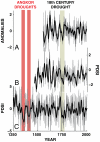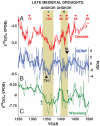Climate as a contributing factor in the demise of Angkor, Cambodia
- PMID: 20351244
- PMCID: PMC2872380
- DOI: 10.1073/pnas.0910827107
Climate as a contributing factor in the demise of Angkor, Cambodia
Abstract
The "hydraulic city" of Angkor, the capitol of the Khmer Empire in Cambodia, experienced decades-long drought interspersed with intense monsoons in the fourteenth and fifteenth centuries that, in combination with other factors, contributed to its eventual demise. The climatic evidence comes from a seven-and-a-half century robust hydroclimate reconstruction from tropical southern Vietnamese tree rings. The Angkor droughts were of a duration and severity that would have impacted the sprawling city's water supply and agricultural productivity, while high-magnitude monsoon years damaged its water control infrastructure. Hydroclimate variability for this region is strongly and inversely correlated with tropical Pacific sea surface temperature, indicating that a warm Pacific and El Niño events induce drought at interannual and interdecadal time scales, and that low-frequency variations of tropical Pacific climate can exert significant influence over Southeast Asian climate and society.
Conflict of interest statement
The authors declare no conflict of interest.
Figures




References
-
- Fletcher RJ, et al. Redefining Angkor: Structure and environment in the largest, low density urban complex of the pre-industrial world. UDAYA. 2003;4:107–121.
-
- Groslier B. La cité hydraulique angkorienne: Exploitation ou surexploitation du sol? Bulletin de l’Ecole française d’Extrême-Orient. 1979;66:161–202.
-
- deMenocal PB. Cultural responses to climate change during the late Holocene. Science. 2001;292:667–673. - PubMed
-
- Haug GH, et al. Climate and the collapse of Maya civilization. Science. 2003;299:1731–1735. - PubMed
-
- Peterson L, Haug G. Climate and the collapse of Maya civilization. Am Sci. 2005;93:322–29. - PubMed
Publication types
MeSH terms
LinkOut - more resources
Full Text Sources

